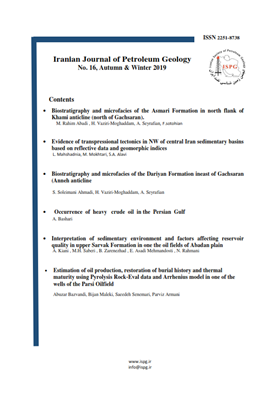Occurrence of heavy crude oil in the Persian Gulf
Subject Areas : Petroleum Reservoir Geology
1 - شرکت ملی نفت ایران
Keywords: Persian Gulf Heavy Crude Oil Qatar Arch Fracturing Facies change Ferdows and farzad fields,
Abstract :
Some of the most prolific petroleum reservoirs with high gravities of oil in the world occured in the Upper Jurassic and Cretaceous carbonate formations in the Persian Gulf area .Most of the reservoirs are composed of pelletal,oolitic ,or bioclastic grainstones and reefal limestone that have high primary porosity and permeability .These reservoirs are sealed either by tight limestone ,massive anhydrite, or by impermeable rocks. The seals are effective throughout most of the Persian Gulf and surrounding areas, Accumulations of heavy oil and natural asphalts on the Iranian side of the Persian Gulf extend NE to SW along the Qatar arch. some of the geological structures which are located along this trend contain heavy oil and natural asphalts within post- Jurassic formations. The major geologic factor which caused accumulations of heavy oil within some geological structures is the Qatar arch. As a result ,some differences appear in lithologic units in two sub-basins northwest and southeast of the Qatar Arch. In general , the occurrence of heavy oil in this trend can be explained as follows; • Fracturing and joints within formation ; • Reduction of thickness of post- Jurassic sediments; • Facies change of Arab reservoirs, cap rock (Hith anhydrite), in some structures from anhydrite to dolomite and also pinchout; The absence of proper environment for the generation of high gravity oil may also be of importance .It should be mentioned that "F" structure (Ferdows), with huge amount of oil in Ratawi and Sulaiy carbonate reservoirs(Lower Cretaceous), is one of the largest heavy oil fields along this trend .The Farsi "B" structure, ( Farzad), with a thick Jahrum formation (Eocene) which has excellent reservoir properties, is filled with natural asphalts.
[1]محمد طیبی، میدان نفت سنگین کوه موند؛ از آغاز تا کنون، اقتصاد انرژی اسفند 1383 شماره 69 و 70 .
[2]محمدجواد غریبی، نفت سنگین مند؛ فرصتی برای توسعه دشتی در پساتحریم Persian Gulf, Professional Analytical News Site. 6/10/1394,
[3]BASHARI., ALIREZA .,1988. Occurrence of Heavy Crude Oil in the Persian Gulf, in R.F. Myer and E. J. Wiggins, (Eds.): Fourth International UNITAR/ UNDP Conference On Heavy crude and Tar Sands, V.2, Geology, Chemistry: International Conference on Heavy Crude and Tar Sands, , Edmonton, Alberta, Canada, 2, 204-214, August 1988.
[4]BASHARI., ALIREZA. 2007, Integrated 3D Seismic and Petrophysical data of the Sarvak Foramtion, Sirri District in the Persian Gulf, (EAGE, First Break, v. 25 ,pp45-53, Regional focus, Middle East).
[5]BASHARI., ALIREZA., 2017. Facies, thickness variations and reservoir characterization of the Arab Formation (Surmeh), Eastern part of the Persian Gulf (Iranian Journal of Petroleum Geology, No.14, pp.95-104. Autum & Winter 2017).
[6]BASHARI., ALIREZA., 2005. Khuff formation Permian-Triassic carbonate in the Qatar-South Fars arch hydrocarbon province, of the Persian Gulf.( EAGE, First Break, V. 23 ,pp 43-50, Nov. 2005, Special topic).
[7]AL- HUSSEINI, M.I., 2000, Origin of the Arabian plate structure- Amar Collision and Najd Rift: Geo Arabia, v. 5, p 527-542.
[8]MURRIS, R.J., 1980, Middle East – Stratigraphic evolution and oil habitat: American Association of Petroleum Geologists Bulletin, v. 64, p. 597-618.
[9]GRABOWSKI, C.G., JR., AND NORTON, I. O., 1995, Tectonic controls on the stratigraphic architecture and hydrocarbon systems of the Arabian Plate, in Al-Husseini, M.I., ed., ed., Gulf Petrolik, Manama, Bahrain, v. 1, p. 413-430.
[10]Thomas Boleantu, 1969, Final Geological Report 3H1 Well, Lavan Petroleum Company.
[11] IROPCO F1 AND F2 Wild cats Persian Gulf, 1967.
[12] GAIRRAUD , 1966, Rapport Geologique Final Du SundageF-B1, Farsi Petroleum Company.
[13]CARREL., C,, 1966, Final Geological Report Well FA-1 Farsi Petroleum Company.
[14]MINA, P., RAZAGNIA., MT, PARAN., Y., 1967 Geological and Geophysical Studies and Exploratory Drilling of Iranian Continental Shelf, Persian Gulf, 7th World Petroleum Congress.
[15]MOSHTAGIAN., A., R. MALEKZADEH AND AZARPANAH., A., 1988.,
Heavy Oil Discovery in Islamic Republic of Iran., in R.F. Myer and E. J. Wiggins, (Eds.): Fourth International UNITAR/ UNDP Conference On Heavy crude and Tar Sands, V.2, Geology, Chemistry: International Conference on Heavy Crude and Tar Sands, , Edmonton, Alberta, Canada, 2, 204-214, August 1988 [16] BASHARI, A. 2008., Thermal History Reconstruction in the Soroosh and the Nowrooz Field, the Persian Gulf, Based on Apatite Fission Track Analysis and Vitrinite Reflection data , ( Journal of Petroleum Geology, V.31, no2 pp.153-165).
[17] KAMALI, M. R. AND REZAEE., M. R., 2003. Burial history reconstruction and modeling at Kuh-e Mond, SW Iran. Journal of Petroleum Geology, vol.26(4), October 2003, pp451-464.


